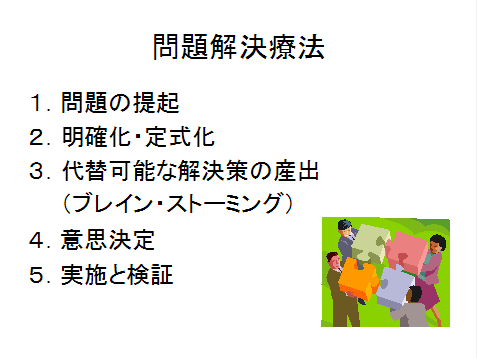診療内容
Menu問題解決療法 Problem-Solving Therapy
最も積極的・効果的な対処方法は「問題解決」です。
そこで、これを治療的に援用した「問題解決療法」をご紹介いたします。具体的に以下の手順に従って進めます。
 (スライドをクリックすると拡大します)
(スライドをクリックすると拡大します)
- 問題の提起
まず問題を知覚することからはじまります。これは「問題への感受性」とも言い、自分や周囲の問題を積極的に気づくことで得られます。
その際は「自分だけの思い込み」といった認知のゆがみ(後述)を排除する必要もあります。
更に、問題を解決することに「積極的・挑戦的」になる態度も求められます。
従って、ある程度の精神的な健康さ、不安や抑うつの改善が前提になります。 - 明確化・定式化
問題が明らかになれば、それは半ば解決したといっても過言ではありません。
しかし、実際のところ、問題は「曖昧・混沌」としていて、なかなか明らかとは言えません。
そこで「情報を集める」「問題の本質を明らかにする」「目標を設定する」「問題を解決する意義を再評価する」ことが必要です。
そして、集められた情報を「分かりやすい言葉で、具体的に、正確に書き出し、まとめること」が有用です。
できれば「図・表」にするとより理解しやすいでしょう。 - 代替可能な解決策の産出
「問題に対して、可能な限り多くの選択肢を挙げ、より良い解決策を得ること」を目指しましょう。
そのためには「拡散的思考」(Guilford), 「ブレイン・ストーミング」(Osborn) を用いましょう。
これは「頭の中に嵐を巻き起こす」という名称の通り、固定観念にとらわれず、様々なアイデアをいくつも考え出しましょう。
「質より量」が重要で、それらを分類したり、組み合わせたりすることにより、更なるアイデアを考え出すことができます。
意思決定するまで「批判や評価を避け」「自由な雰囲気」の中で行うことにより、多くの「代替可能な解決策」を考え出せることができるのです。 - 意思決定
「代替思考な解決策」から「最善の解決策」を決定しましょう。
それには「メリット」「デメリット」を十分に検討しましょう。
評価基準は、問題解決の見込み、心理的な安定、時間や労力、自分・周囲への影響、などです。
評価するには「収束的思考」を必要とします。
「代替可能な解決策」を時間や内容によりまとめ「最善の解決策」へ至るように努めましょう。
このまとめも「図や表」にすると視覚的に理解しやすいことでしょう。 - 実施と検証
「最善の解決策」を「実施・検証」しましょう。
仕事や生活における「有効性・実用性」に注目いたしましょう。
結果を「客観的・具体的」に「観察・記録」すると効果的です。
「時間、金額、回数」など「数値化」するとより良いでしょう。
- 1.問題提起
- 最近、遅刻が多い
- 2.明確化・定式化
- 朝起きられない、夜眠れない、早く帰宅できない
- 3.代替可能な解決策の産出
- 1.早く仕事を終わらせる
2.同僚に手伝ってもらう
3.上司に仕事を減らしてもらう
4.心療内科・精神科を受診する
- 4.意思決定
- 1.可能ならばそれが一番/実際には終わらない
2.自分の仕事は楽になる/同僚も忙しいので頼めない
3.仕事は減らしてもらえる/上司からの評価が下がる
4.睡眠が確実に取れそう/受診には抵抗がある
→仕事は終わらない、職場の援助も得がたい→心療内科を受診する
- 5.実施と検証
- 思い切って心療内科を受診した。
「軽いうつ病」と言われ、薬をもらった。
直ぐ眠れ、朝も起きられるようになった。
しばらくしてから異動し、楽な部署へ移ることができた。
業務に穴を開けず、会社に知られることもなく、無事に乗り切れた
「問題解決療法」について概説いたしました。
ご自身の「生活・行動・認知」などを「客観的に観察」「現実に適応」した「対処・方法」を模索する試みです。
しかし、一人で行うのは困難でしょう。
特に、不安感や抑うつ気分の強い時は「論理的な思考」をしづらいものです。
銀座泰明クリニックでは、必要に応じ、これらの治療を皆様とご一緒に行ってまいります。
詳しくは主治医とご相談くださいませ。
より詳しい内容を知りたい方は、
以下の書籍等をご参照ください。

「精神科地域ケアの新展開‐OTPの理論と実践」
水野雅文・村上雅昭・佐久間啓編、星和書店
Most activities and effectively used coping process is “Problem-Solving”.
Here we will introduce a treatment-type that incorporates this “Problem-Solving Therapy”.
The below procedure will be used:
1. Problem presentation
2. Clarification formulation
3. Potential alternative solution
4. Decision making
5. Implementation / verification
1. Problem presentation
Initially, one should begin with problem perception. This is called problem sensitivity and it is the sensory perception of one`s surrounding problems. For this, one needs to eliminate one`s own assumptions, a type of cognitive disorder. Also, to solve a problem, a positive and challenging attitude is needed. For that reason, moderate mental healthiness and anxiety/depression modification is a pre-requisite.
2. Clarification formulation
Once the problem is identified, solving it can be said to be half complete. However, problems are obscure and not easily understandable. For this reason, it is important to be able to: gather information, identify the root of the problem, establish objectives, re-evaluate the meaning of the problem solving. In order to accomplish this, it is useful to write the collected information in an understandable, objective and accurate way. If possible, it will become easier to comprehend this in a table or diagram format.
3. Potential alternative solutions
In order to reach the best solution, one should think up as many alternatives for the problem. For this, diversion and brainstorming is used. As the name indicates (creating a storm in the head) a person needs to be able to think up many ideas and not be rigid. More than quality, the amount is key, and classifying and arranging these will lead to diverse ideas. Prior to making a decision, one should avoid judgment or evaluation, and should undertake this process in a free atmosphere, in order to derive as many solutions as possible.
4. Decision making
From those derived alternatives, the most appropriate solution will be selected. In order to make this choice, the merits and demerits of the choices should be carefully examined. The standards for decision making are: the prospect is solvable, a prospect for psychological stability, the required time and effort, and the effects on one and their surroundings. For this, cognitive conversion is needed. By understanding the details and time spent on the ideas from divergent thinking, the most suitable idea can be found. It is easiest to put together these ideas in a table or diagram.
5. Implementation / Verification
Verify the result from the selected solutions that were implemented. Particularly in related to work and lifestyle, focus should be one the effectiveness and practicability. For this, it is most effective to objectively observe and record the result. It is best to quantify the frequency, time, and monetary amounts.
Up until now, this has been an explanation of the problem solving method. By objectively observing one`s own lifestyle, behavior and thought process, the most ideal treatment and procedure can be found. However, this is difficult to do by oneself. This can especially be true in cases of strong anxiety and depression that prevent the ability to logically and practically think. At Ginza Taimei Clinic, we are here to work with you on obtaining the correct and required treatment for your situation.
- ホーム
- 診療内容 - 問題解決療法 Problem-Solving Therapy
